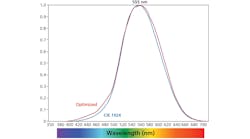LED revenue was $126.7 million, or 86% of the total, compared with $98.9 million last year and $123 million in the previous quarter. LED sales growth was driven by a double-digit increase in XLamp LED components and LED lighting product sales for lighting applications. However, LED chip and high-brightness LED component sales declined by single-digit percentages, due to lower demand in consumer, mobile and automotive applications.
The company's overall revenue figure includes $5.6 million in upfront patent licensing fees from the company’s agreements with Mitsubishi Chemical Corporation (MCC - see news) and Bridgelux (see news). This income, and additional one-time tax-related revenue, was the main reason that Cree beat analyst's revenue estimates of $141 million by a significant margin.
GAAP net income for the second quarter was $10.7 million, or $0.12 per diluted share, compared to net income of $6.6 million, or $0.08 per diluted share, for the year-ago quarter.
Chuck Swoboda, Cree chairman and CEO said that, in the first calendar quarter of 2009, “we expect that lower demand for our products in consumer, mobile and automotive applications will be partially offset by growth in LED sales for commercial lighting applications.”
Current uncertainty in global economic conditions makes it particularly difficult to predict demand, said the company. For the quarter ending March 29, 2009, Cree believes that its revenue will fall sequentially, dropping to the range of $128 million to $135 million with GAAP earnings of $0.02 to $0.05 per diluted share.
“As we look ahead to calendar 2009,” said Swoboda, “we are targeting that LED lighting adoption will continue to gain momentum as product availability increases and recognition of the benefits grows from new installations like the Federal Reserve and the planned Pentagon renovation."




